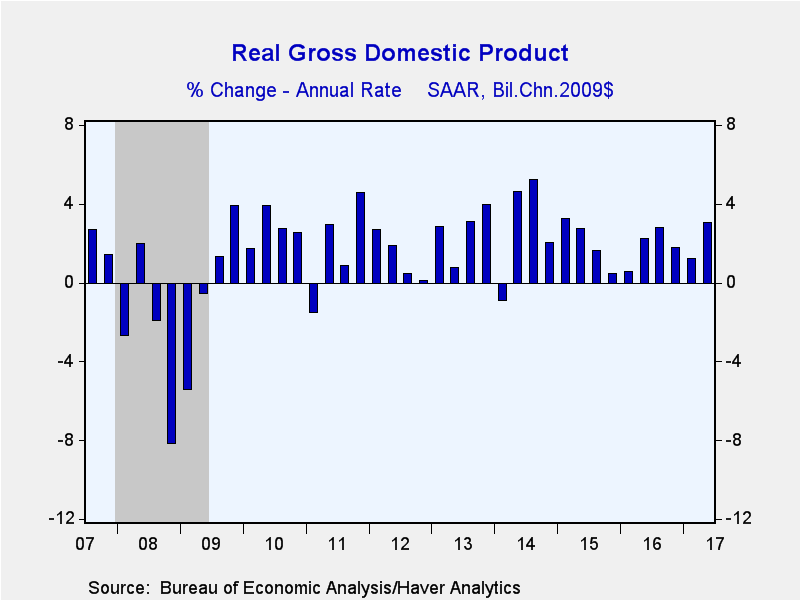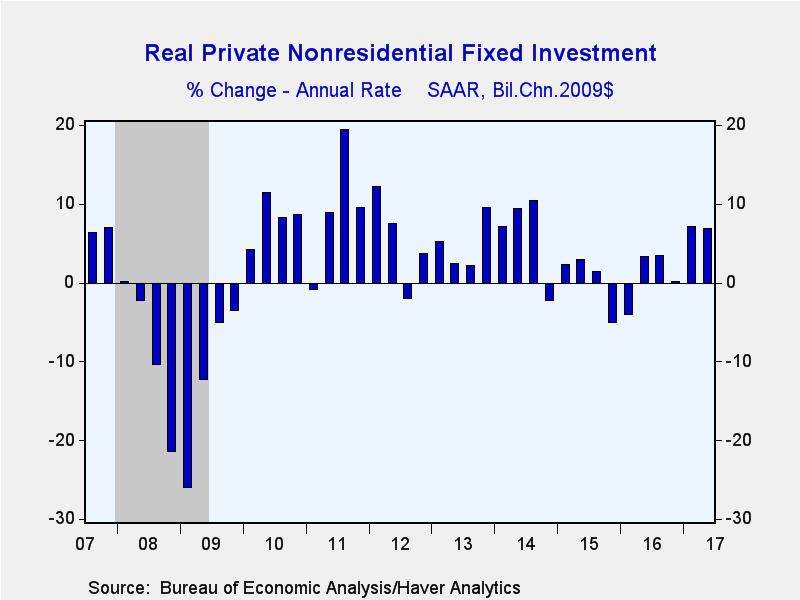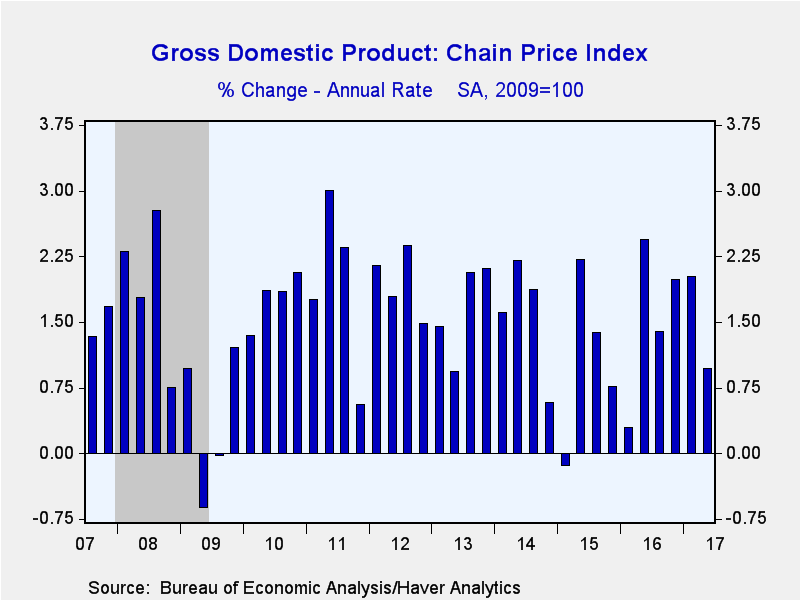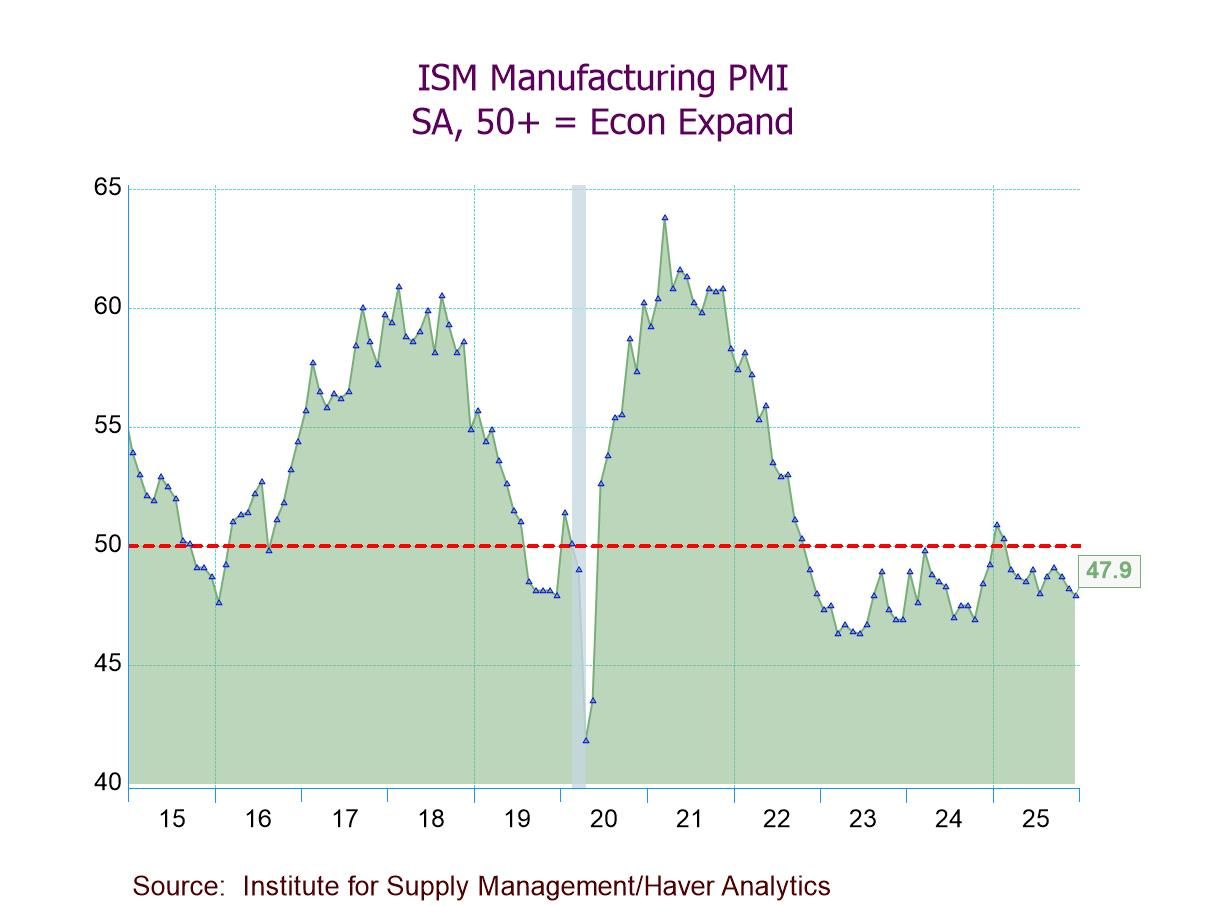 Global| Aug 30 2017
Global| Aug 30 2017U.S. GDP Growth Revised Higher, But Profits Ease
by:Tom Moeller
|in:Economy in Brief
Summary
Economic growth during Q2'17 was revised higher to 3.0% (2.2% y/y) from 2.6% in the advance report. It was the quickest rate of increase since Q1'15. Growth of 2.8% had been expected in the Action Economics Forecast Survey. Reported [...]
Economic growth during Q2'17 was revised higher to 3.0% (2.2% y/y) from 2.6% in the advance report. It was the quickest rate of increase since Q1'15. Growth of 2.8% had been expected in the Action Economics Forecast Survey.
Reported for the first time, after tax corporate profits without IVA & CCA eased 1.4% (+8.1% y/y) and reversed the Q1 increase. Before tax earnings with IVA & CCA improved 1.3% (7.0% y/y) led by a 5.4% rise (7.7% y/y) in nonfinancial sector earnings. Financial sector earnings declined 6.2% (+4.6% y/y) while foreign sector profits fell 2.0% (+7.4% y/y).
An absence of inventory decumulation continued to account for last quarter's acceleration in GDP growth. Inventory change had an unrevised neutral effect on growth after decumulation subtracted 1.5 percentage points in Q1'17 and subtracted 0.4 percentage points during all of last year. Improvement in the foreign trade deficit added an unrevised 0.2 percentage points to growth, as it did during Q1. Exports grew a little changed 3.7% (3.3% y/y) and imports rose 1.6% (4.1% y/y).
Growth in domestic final sales was revised higher to 2.7% (2.4% y/y) from 2.4%. Consumer spending growth was revised up to 3.3% (2.7% y/y) from 2.8%. The gain in durable goods buying was strengthened to 9.0% (6.8% y/y) led by a 14.0% jump (10.9% y/y) in recreational goods & vehicles buying. Home furnishings & appliance purchases rose 9.9% (6.4% y/y) while spending on motor vehicles increased 3.4% (5.0% y/y). Each of these figures were revised higher. Nondurable goods spending rose a slightly increased 4.3% (2.0% y/y). Apparel purchases rose 10.6% (2.3% y/y) while gasoline & energy product consumption rose 6.4% (-1.2% y/y). These figures also were revised slightly higher. Services spending gained 2.1% (2.3% y/y), slightly below growth during the last three years. Spending on housing & utilities grew 3.5% (1.1% y/y) but health care spending eased 0.5% (+2.0% y/y). Recreation spending declined 1.3% (+2.6% y/y).
Business fixed investment growth of 6.9% (4.4% y/y) compared to 5.2% growth reported last month. Growth during the first half of 2017 was the strongest in three years. Spending on equipment increased 8.8% (3.1% y/y) as information processing equipment investment rose a lessened 10.7% (7.0% y/y). Spending on intellectual property products rose an increased 4.9% (3.6% y/y). Spending growth on software was raised, however, to 28.0% (5.2% y/y).
Investment in the residential sector was little revised as it posted a 6.5% decline (+1.5% y/y), reversing roughly half of the Q1 gain.
Government spending was revised to a 0.3% decline (-0.1% y/y) from a 0.7% rise. Federal government spending rose a downwardly revised 1.9% (0.1% y/y) as the gain in defense purchases was lessened to 4.7% (+0.1% y/y). State & local government spending was reduced to a larger 1.7% (-0.4% y/y) decline.
The unrevised 1.0% gain (1.6% y/y) in the GDP price index was half the increases of the prior two quarters. The PCE price index rose 0.3% (1.6% y/y) as the index less food & energy increased 0.9% (1.5% y/y), half the rise during Q1. The nonresidential fixed investment price index rose 1.8% (0.9% y/y), about the same as during Q1, but up from the slight decline in 2016. The residential price index jumped 3.4% (4.1% y/y), on par with last year's increase.
The GDP figures can be found in Haver's USECON and USNA database. USNA contains virtually all of the Bureau of Economic Analysis' detail in the national accounts, including the integrated economic accounts and the recently added GDP data for U.S. Territories. The Action Economics consensus estimates can be found in AS1REPNA.
Tom Moeller
AuthorMore in Author Profile »Prior to joining Haver Analytics in 2000, Mr. Moeller worked as the Economist at Chancellor Capital Management from 1985 to 1999. There, he developed comprehensive economic forecasts and interpreted economic data for equity and fixed income portfolio managers. Also at Chancellor, Mr. Moeller worked as an equity analyst and was responsible for researching and rating companies in the economically sensitive automobile and housing industries for investment in Chancellor’s equity portfolio. Prior to joining Chancellor, Mr. Moeller was an Economist at Citibank from 1979 to 1984. He also analyzed pricing behavior in the metals industry for the Council on Wage and Price Stability in Washington, D.C. In 1999, Mr. Moeller received the award for most accurate forecast from the Forecasters' Club of New York. From 1990 to 1992 he was President of the New York Association for Business Economists. Mr. Moeller earned an M.B.A. in Finance from Fordham University, where he graduated in 1987. He holds a Bachelor of Arts in Economics from George Washington University.












